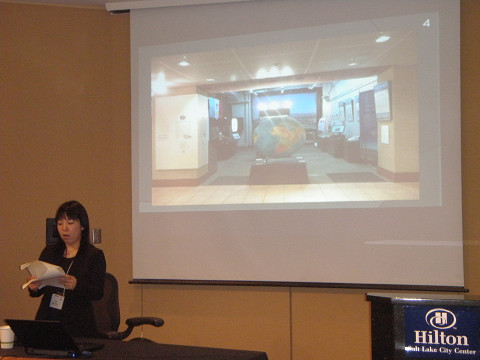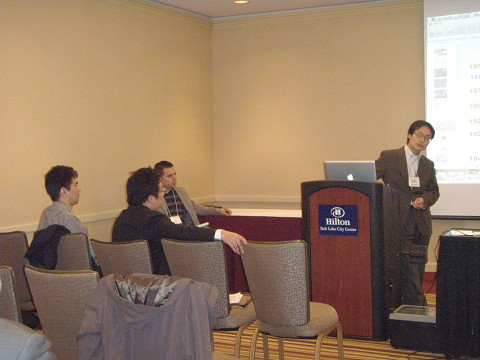
New! SRC Team at the Association of Borderlands Studies (ABS) Annual Conference
2011/04/20
A team of young junior scholars from the Slavic Research Center set off for the Association of Borderlands Studies (ABS) Conference conjunctly held with the Western Social Sciences Association in Salt Lake City, UT that took place between April 13-16. The GCOE program generously funded 3 individual papers as well as a panel.
On April 14, Yuki Sato (Waseda Univ.) and Koji Furukawa (Chukyo Univ.) presented their work °»Border Networking and the Development of Peripheral Initiatives°… at the panel °»Regions as Constructed Places°… where they introduced the current border networking initiative programs conducted by the GCOE program including the Borderland Forum hosted in Yonaguni, the Ogasawara Islands, Nemuro and Tsushima, which are the °»border°… islands and city of Japan. Such an initiative is first of its kind in Japan and they presented their achievements in bringing together the borderland communities to build a network in Japan as well as some challenges that they are facing in terms of involving the policy-making circle in Japan.
The following day, Yuka Mizutani (Center for Ainu and Indigenous Studies, Hokkaido Univ.) presented her work titled °»Presenting the Border through Indigenous Studies: Yaqui Exhibition in Japan°… at the panel °»Power, Perception and Borderlands°…. She presented her project that was jointly conducted with the Hokkaido University Museum on the Yaqui Exhibition which was held at the Museum from December 2010 to April 2011. She talked about her experience of collecting the artifacts and materials in Tuscan, Arizona as well as how the Yaqui exhibit in a faraway country in Japan was received by the Yaqui people. She concluded by emphasizing the importance of the power of visual exhibitions and tapping into people°«s senses to raise awareness of the history and culture of indigenous people.
The last day of the conference included the panel entitled °»Modern and Contemporary Border Issues in Slavic Eurasia°… comprised by Hiroshi Fukuda, Shinkichi Fujimori, and Hiroshi Itani (SRC, Hokkaido Univ.). The panel looked at the borders of the former Soviet space after the collapse of the Soviet Union and the disintegration of the former European communist sphere. Hiroshi Fukuda presented his work °»Imagination for Borderlands-Czech Nation-Building and Body Culture in 19th Century°… which explored the relations between physicality and nationalism and how sports promoted national integration in Czechoslovakia. Shinkichi Fujimori presented his work, °»Border in Eurasia: A Case of Transdnistria°… which analyzed the relations between the unrecognized state of the former Soviet spaces of Transdnistria with Moldova, Ukraine and Russia, which explored the elusive yet practical relations among these state and countries in terms of the economic cooperation. Lastly, Hiroshi Itani presented his work, °»Korsakov and Odormari: Transition of Border and Landscape°… where he illustrated the modern border issues of Sakhalin (former Karafuto) in the 19th and 20th century through the historical tracing of the architecture in Sakhalin.
Also on the last day was a presentation by Naomi Chi (SRC, Hokkaido Univ.) titled °»Canada as a Principle Model of Multiculturalism?: Case Study of the Korean-Canadian Community in Vancouver, Canada°… in the panel °»Security, Human Security, Culture and Multiculturalism: Issues for the US-Canada Border.°… In her presentation, she reviewed the various literature on multiculturalism with an emphasis on Canadian political philosopher Will Kymlicka, examineed the historical background to and the actual policies that have been promoted and enforced in Canada and the application of and challenges to multicultural policies by examining the case study of the Korean-Canadian in Vancouver, British Columbia, Canada.
This year°«s ABS not only included the above individual presentations and panel, but also a showing of the DVD °»The Unknown Tales of the Northern Borders in Japan°… as well as a roundtable discussion °»Conceptualizing the Border in Non-Traditional Regions: Intersecting Academia, NGOs and Government °» as a continuation of the Practitioners Meeting in Tokyo in Dec. 2010.



On April 14, Yuki Sato (Waseda Univ.) and Koji Furukawa (Chukyo Univ.) presented their work °»Border Networking and the Development of Peripheral Initiatives°… at the panel °»Regions as Constructed Places°… where they introduced the current border networking initiative programs conducted by the GCOE program including the Borderland Forum hosted in Yonaguni, the Ogasawara Islands, Nemuro and Tsushima, which are the °»border°… islands and city of Japan. Such an initiative is first of its kind in Japan and they presented their achievements in bringing together the borderland communities to build a network in Japan as well as some challenges that they are facing in terms of involving the policy-making circle in Japan.
The following day, Yuka Mizutani (Center for Ainu and Indigenous Studies, Hokkaido Univ.) presented her work titled °»Presenting the Border through Indigenous Studies: Yaqui Exhibition in Japan°… at the panel °»Power, Perception and Borderlands°…. She presented her project that was jointly conducted with the Hokkaido University Museum on the Yaqui Exhibition which was held at the Museum from December 2010 to April 2011. She talked about her experience of collecting the artifacts and materials in Tuscan, Arizona as well as how the Yaqui exhibit in a faraway country in Japan was received by the Yaqui people. She concluded by emphasizing the importance of the power of visual exhibitions and tapping into people°«s senses to raise awareness of the history and culture of indigenous people.
The last day of the conference included the panel entitled °»Modern and Contemporary Border Issues in Slavic Eurasia°… comprised by Hiroshi Fukuda, Shinkichi Fujimori, and Hiroshi Itani (SRC, Hokkaido Univ.). The panel looked at the borders of the former Soviet space after the collapse of the Soviet Union and the disintegration of the former European communist sphere. Hiroshi Fukuda presented his work °»Imagination for Borderlands-Czech Nation-Building and Body Culture in 19th Century°… which explored the relations between physicality and nationalism and how sports promoted national integration in Czechoslovakia. Shinkichi Fujimori presented his work, °»Border in Eurasia: A Case of Transdnistria°… which analyzed the relations between the unrecognized state of the former Soviet spaces of Transdnistria with Moldova, Ukraine and Russia, which explored the elusive yet practical relations among these state and countries in terms of the economic cooperation. Lastly, Hiroshi Itani presented his work, °»Korsakov and Odormari: Transition of Border and Landscape°… where he illustrated the modern border issues of Sakhalin (former Karafuto) in the 19th and 20th century through the historical tracing of the architecture in Sakhalin.
Also on the last day was a presentation by Naomi Chi (SRC, Hokkaido Univ.) titled °»Canada as a Principle Model of Multiculturalism?: Case Study of the Korean-Canadian Community in Vancouver, Canada°… in the panel °»Security, Human Security, Culture and Multiculturalism: Issues for the US-Canada Border.°… In her presentation, she reviewed the various literature on multiculturalism with an emphasis on Canadian political philosopher Will Kymlicka, examineed the historical background to and the actual policies that have been promoted and enforced in Canada and the application of and challenges to multicultural policies by examining the case study of the Korean-Canadian in Vancouver, British Columbia, Canada.
This year°«s ABS not only included the above individual presentations and panel, but also a showing of the DVD °»The Unknown Tales of the Northern Borders in Japan°… as well as a roundtable discussion °»Conceptualizing the Border in Non-Traditional Regions: Intersecting Academia, NGOs and Government °» as a continuation of the Practitioners Meeting in Tokyo in Dec. 2010.









